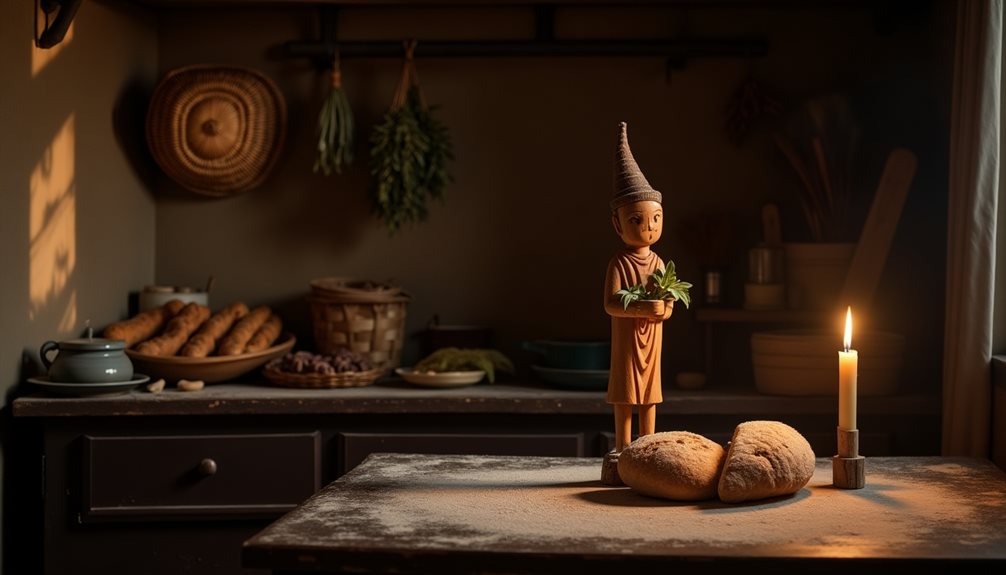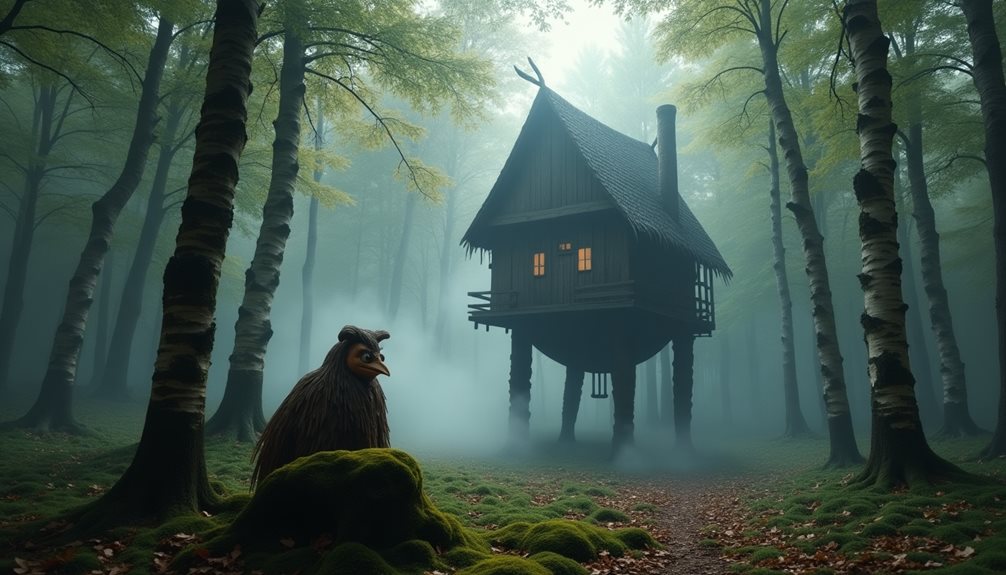Baba-Yaga stands out as one of the most fascinating and ambiguous figures in Russian folklore. She lives deep in the forest in a hut perched on chicken legs and is simultaneously feared and sought after. Sometimes she helps lost travelers or reveals hidden truths; at other times, she devours those who cross her. Her character embodies both the cruelty and wisdom of nature—a force to respect and never underestimate. The forest itself is central in many Russian tales, serving as a place of danger but also of transformation, where heroes confront their deepest fears and emerge changed.
The tales often feature magical objects such as the Firebird, a glowing bird whose feathers light up the night and promise both great fortune and great peril to those who seek it. Magic in Russian folklore is rarely straightforward; wishes come with consequences, and gifts often test a person’s character. These stories teach lessons about humility, respect for forces beyond human control, and the importance of cleverness over brute strength.
Legendary creatures such as Koschei the Deathless further complicate the landscape. Koschei cannot be killed because his soul is hidden away in a needle inside an egg, which is itself hidden within a series of animals and objects. Heroes must embark on perilous journeys to uncover these secrets—a motif that speaks to ideas of immortality and the cyclical nature of life and death.
Even today, echoes of these beliefs remain in Russian art, literature, and everyday superstitions. Characters like Baba-Yaga and the Domovoi have inspired countless fairy tales, ballets, paintings, and films. Through these stories, Russians have preserved their connection to nature’s mysteries and the wisdom of their ancestors. The enduring appeal of these myths lies in their ability to both enchant and instruct, reflecting universal human questions about fate, courage, and the unknown.
Table of Contents
ToggleThe Enigmatic Domovoi: Guardian of the Home

The Domovoi (домовой) occupies a unique and vital place in Russian folklore as the protective household spirit, closely connected to the daily lives of families across generations. Though not as widely recognized as other mythological beings, the Domovoi’s presence is felt in nearly every traditional Russian home, embodying the soul (душа — dusha) and luck (удача — udacha) of the household.
According to ancient Slavic beliefs, the Domovoi is typically envisioned as a small, elderly man with a long, grey beard (борода — boroda), sometimes covered in animal hair or even resembling the family’s ancestors. His demeanor can range from kindly and helpful to stern and mischievous, depending on how he is treated by the members of the household. The name itself comes from “dom” (дом), meaning “house.”
The primary role of the Domovoi is that of a guardian (хранитель — khranitel’). He protects the home from misfortune, evil spirits, and even fire. It is believed that the Domovoi takes particular care of children and livestock, ensuring their safety and health. When honored properly, he brings prosperity (благополучие — blagopoluchie) and tranquility (спокойствие — spokoystvie) to the family.
Families have traditionally maintained a strong relationship with their Domovoi through simple rituals and customs:
- Offerings: Bread (хлеб — khleb), milk (молоко — moloko), or even a pinch of salt (соль — sol’) are placed in a special corner of the kitchen or near the stove (печь — pech’), which is considered his favorite spot.
- Respectful behavior: Loud quarrels, disrespectful language, or neglecting household chores are believed to anger the Domovoi, potentially leading to disturbances or bad luck.
- Moving house: When relocating, families would invite their Domovoi to come along by saying, “Domovoi, domovoi, come with us to the new home!” (Домовой, домовой, пойди с нами в новый дом!)
Signs of the Domovoi’s displeasure might include mysterious noises at night, misplaced objects, or disturbed pets. On the other hand, warmth in the house, peaceful sleep, and thriving animals are interpreted as signs of his favor.
The enduring figure of the Domovoi highlights the importance Russians place on domestic harmony and unity (единство — yedinstvo). Far more than a superstition, he remains a symbol of the invisible bonds that tie families together and safeguard their well-being.
![]()
Baba-Yaga: The Fearsome Forest Witch
In stark contrast to the nurturing presence of the Domovoi, Baba-Yaga emerges as a formidable figure in Russian folklore, representing the wild and unpredictable forces of nature.
Baba-Yaga (Баба-Яга) is one of the most famous and complex figures in Russian folklore, both feared and respected throughout the Slavic world. Unlike the comforting spirit of the Domovoi (Домовой), Baba-Yaga represents the wild, unpredictable, and often dangerous forces of nature. She is neither entirely evil nor completely good, but instead captures the dual nature of the forest—capable of both nurturing and destroying.
Her appearance is unforgettable. Baba-Yaga is often described as an old woman (старая женщина) with iron teeth (железные зубы), a hooked nose (крючковатый нос), and wild, tangled hair (спутанные волосы). She travels through the forest in a magical mortar (ступа), moving herself along with a pestle (пестик) and sweeping away her tracks with a birch broom (метла из берёзы). These images connect her deeply to the ancient, earthy magic of the Russian woods.
Her home is perhaps even more legendary: a hut standing on chicken legs (избушка на курьих ножках). This house can spin around, move through the forest, or hide its entrance from visitors. To gain entry, heroes in fairy tales use the phrase “Избушка, избушка, повернись к лесу задом, ко мне передом” (“Little hut, little hut, turn your back to the forest, your front to me”), showing that cleverness is needed even before meeting Baba-Yaga herself.
Inside her unusual home, Baba-Yaga keeps collections of herbs (травы), bones (кости), and magical objects (волшебные предметы), marking her as both a healer (целительница) and a guardian of secrets. She knows the mysteries of life and death, transformation, and the hidden powers of the forest. Many stories feature people seeking her out for advice, healing remedies, or guidance through difficult quests.
Baba-Yaga stands as a gatekeeper between worlds—between life and death, childhood and adulthood, safety and peril. She tests those who enter her territory with riddles (загадки) or impossible challenges (испытания), like separating poppy seeds from sand or finishing demanding chores overnight. To succeed, visitors need not just courage (храбрость), but also cleverness (смекалка) and humility (смирение).
Despite her fearsome reputation, Baba-Yaga is not always an enemy. When treated with respect (уважение) and honesty (честность), she can reward visitors with magical gifts (волшебные подарки) or enchanted objects—sometimes a flying horse or a magical towel that creates rivers to protect the hero. Her unpredictable nature means only those who are truly worthy gain her help.
Some key Russian words and phrases connected to Baba-Yaga include:
- Баба-Яга (Baba-Yaga) — Baba-Yaga
- Лес (les) — forest
- Ступа и пестик (stupa i pestik) — mortar and pestle
- Куриные ножки (kurinye nozhki) — chicken legs
- Избушка на курьих ножках (izbushka na kuryikh nozhkakh) — hut on chicken legs
- Загадка (zagadka) — riddle
- Испытание (ispytaniye) — task or challenge
- Волшебство (volshebstvo) — magic
For centuries, tales of Baba-Yaga have captivated listeners across Russia and Eastern Europe. She reflects both the awe-inspiring and unpredictable power of the natural world, teaching children and adults to treat the unknown with caution but also curiosity. Through her tests, she imparts lessons about bravery, resourcefulness, and empathy.
Baba-Yaga ultimately stands as a symbol of transformation. Her stories show that stepping into the unknown can be frightening but also full of possibility; those who enter her domain with an open mind may return wiser and more courageous. This complexity has kept Baba-Yaga at the heart of Russian storytelling for generations, making her both a fearsome witch and a cherished figure in myth.
The Mythical Firebird: A Symbol of Hope and Renewal
While the mythical Firebird captivates the imagination with its radiant plumage and extraordinary abilities, it serves a deeper purpose within Russian folklore as a symbol of hope and renewal. Firebird symbolism resonates through various tales, representing the cyclical nature of life and rebirth. Often sought after by heroes, the Firebird embodies the promise of transformation and the pursuit of dreams. Its enchanting presence in renewal narratives highlights the possibility of overcoming obstacles and restoring balance.
The Firebird (Жар-птица, Zhar-ptitsa) is one of the most famous creatures in Russian folklore, often depicted as a magical bird with glowing feathers that light up the night. Legends describe how it brings both challenge and fortune to those who seek it, making it a symbol of hope, renewal, and the constant cycle of life.
The Firebird in Russian Folktales
In Russian fairy tales, the Firebird is usually a prize or a sign that sends the hero on a quest. Finding the Firebird is rarely simple—it requires bravery, cleverness, and sometimes kindness. The journey often leads to self-discovery and personal growth.
![]()
Key story elements:
- The Firebird’s feather glows brightly, guiding heroes in the darkness.
- Capturing the Firebird can grant wishes or restore lost prosperity.
- The Firebird’s appearance often signals a turning point in the story, where despair gives way to hope.
Example from Russian Folklore
A famous tale is “Ivan Tsarevich and the Grey Wolf,” where Prince Ivan finds a glowing Firebird feather and is tasked by his father to capture the bird. His journey is filled with challenges, but with the help of the wise Grey Wolf, he not only finds the Firebird but also achieves personal growth and happiness.
![]()
Related Russian Terms
| Russian (Cyrillic) | Pronunciation | English Definition |
|---|---|---|
| Жар-птица | Zhar-ptitsa | Firebird |
| Перо | Pero | Feather |
| Светиться | Svetit’sya | To glow / shine |
| Сказка | Skazka | Fairy tale |
| Герой | Geroi | Hero |
| Надежда | Nadezhda | Hope |
| Возрождение | Vozrozhdenie | Renewal / rebirth |
| Преображение | Preobrazhenie | Transformation |
| Процветание | Protsvetanie | Prosperity |
| Исполнить желание | Ispolnit’ zhelaniye | Grant a wish |
Use these words to expand your vocabulary as you read or hear stories about the Firebird. They will help you understand not just the plot, but also the deeper symbolism found in Russian folklore.
Leshy: The Spirit of the Forest
Leshy (Леший), known as the spirit or guardian of the forest in Russian folklore, is a mysterious and powerful figure deeply ingrained in Slavic mythology. The name Леший originates from the Old Slavic word “лес” (les), meaning “forest,” highlighting his intrinsic connection to woodland environments.
Appearance and Shape-Shifting Abilities
Leshy is traditionally described as a tall, humanoid figure covered in foliage, with green or mossy hair and a beard made of leaves and vines. His eyes are said to glow with an eerie light, and his size can change at will—from towering over the tallest trees to shrinking down to the size of a blade of grass. This shape-shifting ability (способность менять форму) allows him to blend seamlessly with the forest, often appearing as a tree, bush, or animal.
Role as the Forest Guardian
As a protector of the лес (forest), Leshy’s primary role is to maintain the balance between humans and nature. He ensures that people respect the woods and do not exploit or harm them recklessly. In folklore, he punishes those who disrespect the forest by leading them astray or causing confusion. Travelers might find themselves hopelessly lost, walking in circles or encountering strange sounds and illusions.
- Forest protection (защита леса): Leshy’s presence is a warning against deforestation and disrespecting wildlife.
- Keeper of animals (хранитель животных): He watches over the creatures of the forest, sometimes taking the form of animals himself.
- Controller of weather (контролёр погоды): Some tales attribute to Leshy control over forest weather patterns like fog, rain, and wind.
Personality and Behavior
Leshy’s character is complex; he is both a trickster and a protector. He can be whimsical and mischievous, delighting in confusing humans, but also helpful to those who show reverence and behave respectfully in his domain. His mood can shift quickly—friendly one moment and dangerous the next—reflecting the unpredictable nature of the wilderness.
Cultural Significance
In Russian culture, Leshy symbolizes the wildness and mystery of nature. His stories serve as moral lessons about living in harmony with the environment. The phrase “Не ходи в лес без уважения” (“Do not go into the forest without respect”) echoes this traditional wisdom.
Key Russian Words and Phrases Related to Leshy:
- Леший (Leshy) — Forest spirit or guardian
- Лес (Les) — Forest
- Дух леса (Dukh lesa) — Spirit of the forest
- Защита леса (Zashchita lesa) — Forest protection
- Менять форму (Menjat’ formu) — To change shape/shape-shift
- Хранить природу (Khranit’ prirodu) — To protect nature
- Заблудиться в лесу (Zabludit’sya v lesu) — To get lost in the forest
- Природное равновесие (Prirodnoe ravnovesie) — Natural balance
- Уважение к природе (Uvazhenie k prirode) — Respect for nature
Interesting Details
- Leshy is sometimes described as having a family—his wife (Лешачиха) and children—who share his protective role over different parts of the forest.
- Folk tales often mention Leshy’s ability to mimic human voices, calling out to wanderers to lure them deeper into the woods.
- In some regions, people would leave offerings or perform rituals to appease Leshy before entering dense forests.
- Leshy is sometimes linked with other Slavic forest spirits like Rusalka (русалка), a water nymph, highlighting a rich tapestry of nature deities in Slavic folklore.
Leshy remains a powerful symbol reminding us of the importance of respecting nature’s boundaries and preserving the delicate ecosystems within forests. His stories continue to inspire cultural works such as literature, art, and film throughout Russia and Eastern Europe.
The Tale of Koschei the Deathless: Immortality and Folly
Koschei the Deathless (Кощей Бессмертный, Koschey Bessmertny) is one of the most intriguing figures in Russian folklore, embodying a complex blend of power, mystery, and tragedy. His story has been passed down through generations, captivating audiences with its rich symbolism and deep philosophical questions about life (жизнь, zhizn), death (смерть, smert), and the human condition. In Russian culture, Koschei represents more than just a villain; he is a symbol of the consequences of seeking to escape the natural cycle of life.
The legend of Koschei dates back centuries and is often featured in traditional Russian fairy tales (сказки, skazki), where he is portrayed as an immortal (бессмертный, bessmertny) sorcerer whose death (смерть, smert) is hidden away in an elaborate and almost impossible-to-find object—a needle (игла, igla) inside an egg (яйцо, yaytso), which is inside a duck (утка, utka), inside a hare (заяц, zayats), locked in a chest (сундук, sunduk) buried beneath a green oak tree (дуб, dub) on the island of Buyan. This unique motif highlights the idea that no matter how powerful someone may be, they are never truly invincible if their mortality is cleverly concealed. It also reflects the deep-rooted Slavic belief in interconnectedness between life (жизнь, zhizn), nature (природа, priroda), and fate (судьба, sudba).
Historically, Koschei’s character may have been influenced by ancient pagan beliefs and the harsh realities of medieval Russian life, where survival often depended on cunning (хитрость, khitrost) and resilience. His immortality (бессмертие, bessmertie), rather than being a gift, turns into a curse (проклятие, proklyatie)—he becomes a lonely figure trapped by his own desire to cheat death (смерть, smert). This aspect of the tale resonates profoundly with Russian cultural values that honor the natural order, humility (смирение, smirenie), and the acceptance of life’s impermanence.
What makes Koschei’s story particularly uplifting is the underlying message about the limits of power (власть, vlast) and the importance of compassion (сострадание, sostradanie) and connection. Despite his seemingly invincible nature, Koschei’s downfall comes from his inability to embrace change and relinquish control. This serves as a reminder that true strength lies not in dominating others or escaping fate (судьба, sudba) but in understanding one’s place in the world and living with integrity (честность, chestnost).
Russian folklore often uses characters like Koschei to teach valuable lessons through vivid storytelling. His tale encourages readers to reflect on their own lives—on the dangers of obsession (одержимость, oderzhimost) and the beauty of accepting life’s natural flow. It celebrates human resilience and wisdom while honoring Russia’s rich cultural heritage (наследие, nasledie) and storytelling tradition.
In this way, Koschei the Deathless remains a powerful and relevant figure, inspiring pride in Russia’s folklore and reminding us all that immortality without meaning is a hollow existence. His story continues to be cherished not only for its imaginative depth but also for its timeless insights into the human spirit.
![]()
Frequently Asked Questions
What Are the Origins of Russian Mythology and Folklore?
The origins of Russian mythology and folklore are deeply rooted in Slavic traditions, shaped by historical influences such as the Christianization of Kievan Rus, which intertwined ancient beliefs with evolving cultural narratives and societal values.
How Do Russian Myths Compare to Other Cultural Myths?
Russian myths exhibit cultural similarities to global folklore, featuring mythical archetypes such as heroes, tricksters, and guardians. These stories reflect universal themes, revealing humanity’s shared experiences while maintaining distinct regional characteristics that enrich their narrative fabric.
Are There Modern Interpretations of These Legends?
Modern interpretations of Russian legends manifest through contemporary retellings in literature and film, showcasing adaptability. These modern adaptations often blend traditional elements with current themes, reflecting societal changes while preserving the essence of the original folklore.
What Role Do Animals Play in Russian Folklore?
Animals in Russian folklore often embody rich animal symbolism, representing various human traits. Trickster figures, like the cunning fox, challenge societal norms, reflecting the duality of nature and humanity’s complex relationship with the wild and the mystical.
How Are These Tales Passed Down Through Generations?
Tales are transmitted through oral traditions, where storytellers utilize varied storytelling techniques to engage listeners. This dynamic exchange fosters cultural identity, preserving narratives that reflect communal values, beliefs, and the rich fabric of human experience.



